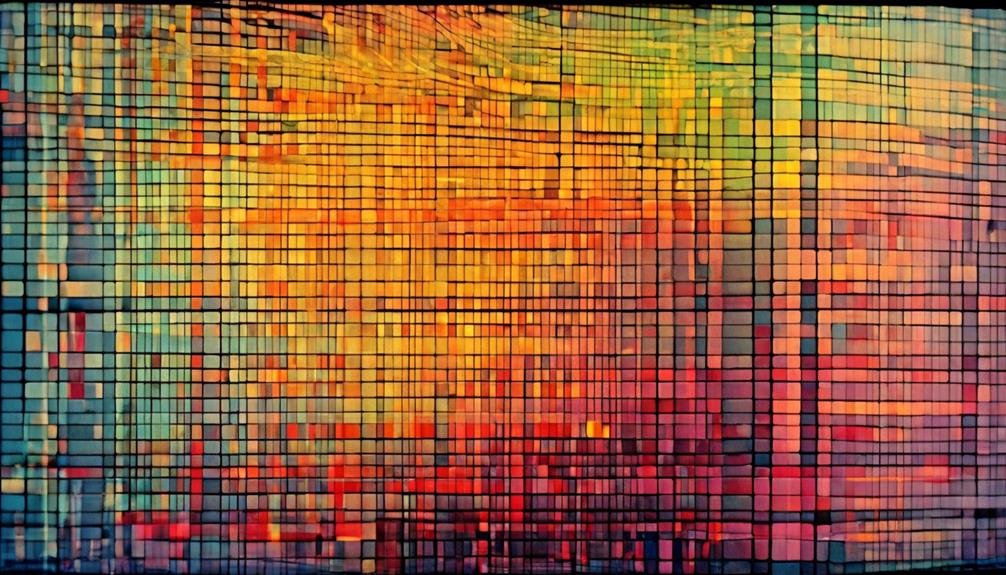
Color accuracy in image sensors is like a puzzle with multiple pieces – each one playing a crucial role in the final picture. From the sensor type and technology to the intricate process of demosaicing, numerous factors contribute to the reproduction of accurate colors in digital images. Understanding these elements is essential for anyone seeking to capture or reproduce true-to-life colors in their photographs or videos. But how do these complex components work together to determine color accuracy, and what are the key considerations that professionals should keep in mind when evaluating the performance of image sensors?
Sensor Type and Technology
In image sensor technology, the choice of sensor type and technology directly influences the color accuracy and overall performance of the device. The pixel size and layout are crucial aspects of sensor technology that impact color accuracy. Larger pixels generally capture more light, leading to improved color accuracy, especially in low-light conditions. Additionally, the layout of pixels on the sensor can affect how color information is captured and processed, further influencing the final color accuracy of the image.
Furthermore, noise reduction techniques play a vital role in enhancing color accuracy. By minimizing noise, which can distort color information, the sensor technology can deliver more accurate and true-to-life colors. Advanced noise reduction algorithms and technologies are continually being developed to address this challenge, contributing to significant improvements in color accuracy in image sensors.
Color Filter Array (CFA)
The impact of sensor technology on color accuracy is further elucidated through the examination of Color Filter Array (CFA) designs and their role in capturing and processing color information. The CFA, commonly known as the Bayer pattern, is a mosaic filter placed over the pixels of an image sensor to allow each pixel to capture only one of the three primary colors: red, green, or blue. The following points shed light on the significance of CFA in color accuracy:
- Bayer Pattern: The Bayer pattern, a widely used CFA, arranges green, red, and blue filters in a 2×2 grid, allowing for efficient capture of color information.
- Mosaic Interpolation: CFA requires mosaic interpolation to reconstruct full-color information for each pixel, a process that involves estimating the missing color values by analyzing neighboring pixels.
- Color Accuracy: The effectiveness of CFA and mosaic interpolation directly impacts color accuracy, as any errors or inconsistencies in this process can result in inaccuracies in the final image.
- Innovation in CFA Designs: Ongoing research focuses on developing advanced CFA designs and interpolation algorithms to enhance color accuracy in image sensors.
Understanding the intricacies of CFA and its role in capturing color information is crucial for advancing color accuracy in image sensors.
Signal Processing and Demosaicing

Exploring the intricacies of signal processing and demosaicing allows for a comprehensive understanding of how image sensors transform raw data into accurate and vibrant color representations. In this process, noise reduction plays a crucial role in improving the overall image quality. By employing various algorithms and techniques, such as spatial and temporal noise reduction, image sensors can effectively minimize unwanted artifacts and enhance the clarity of the captured images.
Additionally, pixel interpolation is a key aspect of demosaicing that contributes to the final color accuracy. Through this process, the missing color information for each pixel is estimated based on neighboring pixels with known color values. Advanced interpolation methods, including bilinear, bicubic, and adaptive algorithms, enable image sensors to interpolate the missing color data with higher precision, resulting in sharper and more detailed images.
Innovations in signal processing and demosaicing continue to drive advancements in image sensor technology, leading to improved color accuracy and overall image quality. As these technologies evolve, the quest for even more accurate and vibrant color representations remains at the forefront of image sensor development.
White Balance and Color Profiles
Advancing from our exploration of signal processing and demosaicing, we now turn our attention to the critical aspects of white balance and color profiles in achieving optimal color accuracy in image sensors.
White balance is essential for accurate color reproduction as it ensures that whites appear truly white regardless of the light source. Color temperature, measured in Kelvin, dictates the warmth or coolness of the light and directly influences white balance settings.
Color correction is pivotal in adjusting the captured colors to align with the known reference colors, thereby enhancing color accuracy. Utilizing color profiles allows for standardized color representation across different devices and applications, ensuring consistency in color reproduction.
Understanding the impact of varying light sources on color temperature and implementing precise color correction techniques is fundamental to achieving impeccable color accuracy in image sensors. By integrating customizable color profiles, we can elevate the standardization and fidelity of color reproduction in imaging technology.
Spectral Sensitivity and Color Reproduction

Spectral sensitivity influences the precise reproduction of colors in image sensors by dictating their response to different wavelengths of light. Image sensors are designed with specific spectral sensitivity to accurately capture and reproduce colors. This sensitivity is determined by the materials used in the sensor's photodetectors and the sensor's calibration process. The photodetectors' sensitivity to different light wavelengths directly affects the sensor's ability to faithfully capture the colors present in a scene. This is crucial for achieving accurate color reproduction in digital images.
Light wavelengths interact differently with the sensor's photodetectors based on their spectral sensitivity, impacting how colors are rendered in the final image. Sensor calibration plays a vital role in ensuring that the spectral sensitivity is accurately accounted for and calibrated to represent colors as faithfully as possible. By understanding and manipulating the spectral sensitivity of image sensors, advancements can be made in improving color accuracy and reproduction, leading to innovations in digital imaging technology. This ongoing exploration of spectral sensitivity is instrumental in pushing the boundaries of color accuracy and fidelity in image sensors.
Frequently Asked Questions
How Do Image Sensors Handle Color Accuracy in Low Light Conditions?
In low light conditions, image sensors manage color accuracy by employing advanced low light noise reduction and white balance techniques. These methods enhance color fidelity and minimize color distortion, ensuring accurate image capture.
Can Image Sensors Accurately Reproduce Colors in Extreme Temperature Conditions?
Image sensors use temperature compensation to maintain color accuracy in extreme conditions. Temperature impact can affect color reproduction, but advanced technology ensures accurate results. We prioritize innovation to address challenges and deliver reliable performance.
What Impact Does the Size of the Individual Pixels on an Image Sensor Have on Color Accuracy?
Pixel size directly impacts color reproduction, noise reduction, and dynamic range in image sensors. Larger pixels capture more light, improving color accuracy and reducing noise. This enhances overall image quality, especially in low-light conditions.
How Do Image Sensors Handle Color Accuracy When Capturing Fast-Moving Objects?
Capturing color accuracy in fast-moving objects can be challenging for image sensors. Motion blur can impact color reproduction, and temperature sensitivity may also affect accuracy. Advanced sensor technology is constantly evolving to address these issues.
Are There Specific Environmental Factors That Can Affect the Color Accuracy of Image Sensors?
Lighting conditions and humidity affect image sensor color accuracy. Calibration and exposure management are crucial. These environmental factors influence the sensor's ability to capture accurate colors. Understanding and mitigating these influences are essential for precise image reproduction.
